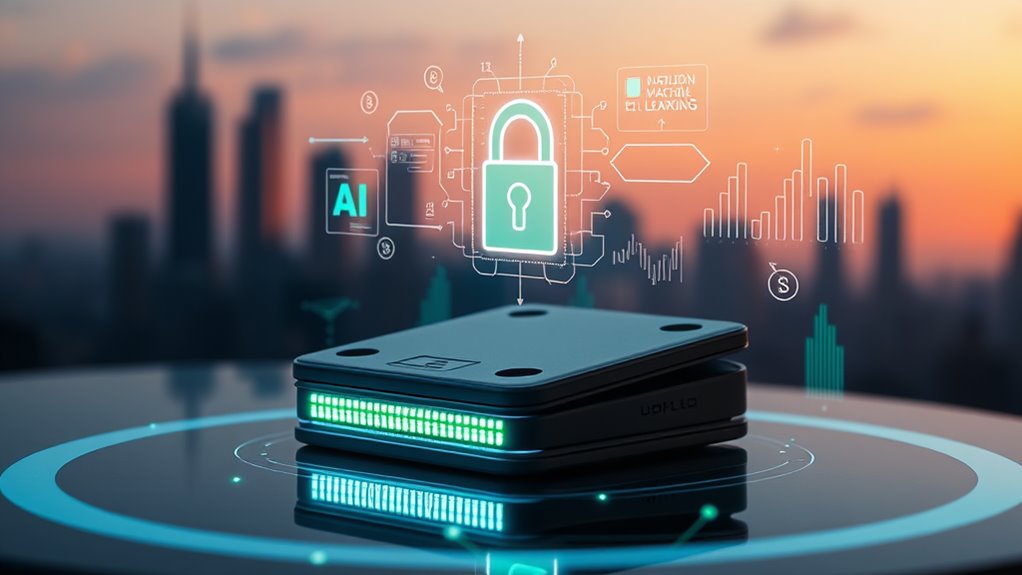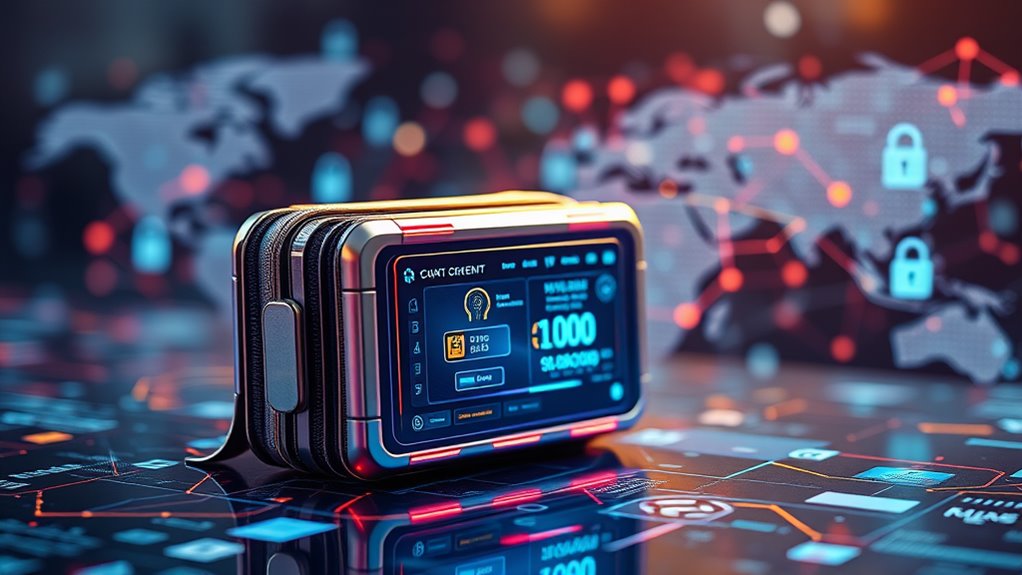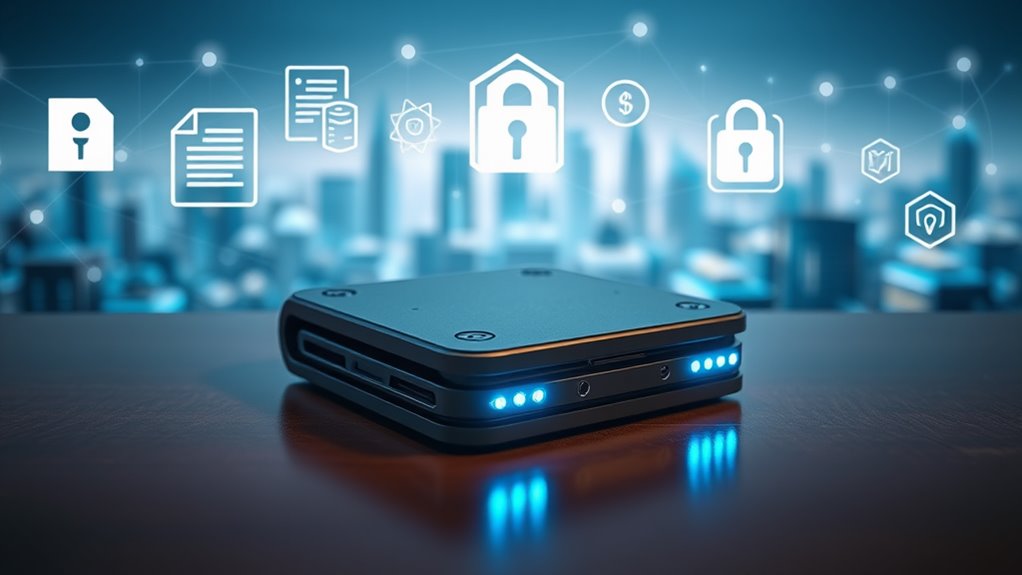
Future of Crypto Wallets: Trends & Innovations Shaping Security
The future of crypto wallets is being shaped by various trends and innovations. Enhanced security measures, such as homomorphic encryption and multi-signature wallets, are essential for protecting user data. AI and machine learning are transforming wallet functionalities through automated transaction approvals and market analysis. Additionally, cross-chain compatibility allows seamless asset transfers between different networks. Regulatory compliance is also evolving with AML and KYC measures. Exploring these developments reveals a landscape of advanced wallet solutions.
Key Takeaways
- Enhanced security through homomorphic encryption and zero-knowledge proofs will protect user data while enabling secure transactions in crypto wallets.
- AI and machine learning will automate transaction approvals and provide personalized recommendations, improving user experience and efficiency.
- Cross-chain compatibility will facilitate seamless asset transfers between different blockchain networks, creating a more unified decentralized ecosystem.
- Regulatory compliance measures, such as AML and KYC, will strengthen the legitimacy of crypto wallets while balancing user privacy concerns.
- Innovations in hardware wallets, including cold storage and biometric authentication, will enhance security and broaden functionality for users managing digital assets.
Enhanced Security Measures in Crypto Wallets

In the rapidly evolving landscape of cryptocurrency, enhanced security measures in crypto wallets are becoming increasingly essential for protecting digital assets. Techniques such as homomorphic encryption allow for computations on encrypted data, ensuring confidentiality during transactions.
Zero-knowledge proofs help verify information without exposing sensitive data, bolstering privacy. Multi-party computation and secure multi-party computation enable secure collaborations without revealing individual inputs, enhancing trust among users.
Additionally, adopting quantum-resistant cryptography prepares wallets for future threats posed by quantum computing. Network protections, including TLS/SSL encryption and VPNs, safeguard data during transmission.
Multi-signature wallets and two-factor authentication add layers of security, requiring multiple approvals for transactions. Multisig wallets can significantly reduce the risk of unauthorized access by requiring multiple signatures from different private keys for transaction authorization. Collectively, these measures work towards creating a more secure environment for cryptocurrency storage and transactions.
The Role of AI and Machine Learning in Wallet Functionality

The integration of artificial intelligence (AI) and machine learning into crypto wallets greatly enhances their functionality, providing users with smarter and more efficient tools for managing their digital assets.
These technologies offer significant benefits, including:
These technologies provide users with automated transaction approvals, real-time market analysis, and personalized recommendations for a superior experience.
- Automated transaction approval, allowing users to execute transactions based on preset conditions for seamless operations.
- Real-time market analysis, which delivers actionable insights to make informed transaction decisions based on current trends.
- Personalized recommendations, tailoring advice based on individual transaction history and market conditions to optimize user experience.
Cross-Chain Compatibility and Its Importance

Cross-chain compatibility plays an essential role in the evolving landscape of cryptocurrencies, as it allows different blockchain networks to communicate and transfer assets seamlessly. This capability enhances liquidity, reduces transaction costs, and encourages broader adoption across decentralized applications. Key technologies facilitating this compatibility include atomic swaps, blockchain bridges, and interoperability protocols.
| Feature | Benefit | Importance |
|---|---|---|
| Seamless Communication | Direct asset transfers | Facilitates smart contract execution |
| Unified Ecosystem | Less fragmentation | Strengthens the decentralized economy |
| Collaborative Environment | Resource sharing across networks | Encourages innovation |
| Accelerated Transactions | Faster digital currency exchanges | Enhances user experience |
| Diverse Asset Access | Manage multiple cryptocurrencies | Simplifies user interaction |
Cross-chain compatibility is fundamental for a cohesive and efficient crypto landscape.
Navigating Regulatory Compliance for Crypto Wallets

As the cryptocurrency landscape continues to evolve, the need for regulatory compliance in crypto wallets has become increasingly important.
Wallet providers must navigate a complex web of regulations to guarantee lawful operations. Key compliance factors include:
- Anti-Money Laundering (AML) Measures: Implementing safeguards to prevent illicit activities.
- Know Your Customer (KYC) Policies: Verifying identities to combat fraud and guarantee user safety.
- Tax Compliance: Adhering to tax obligations and reporting requirements for gains and losses.
These regulations not only protect users but also enhance the legitimacy of cryptocurrencies in the financial ecosystem. Additionally, implementing robust security measures such as hardware wallets can further ensure that compliance does not compromise the security of users’ digital assets.
However, striking a balance between compliance and user privacy remains a significant challenge for wallet providers, necessitating innovative solutions to meet evolving regulations while safeguarding user data.
The Evolution of Hardware Wallets and Their Innovations

Over the past few years, hardware wallets have undergone significant evolution, driven by advancements in technology and the growing demand for secure cryptocurrency storage.
Innovations such as cold storage protect private keys offline, while secure elements enhance resistance to physical tampering. Multi-signature support requires multiple approvals for transactions, adding an extra layer of security.
Cold storage safeguards private keys offline, while multi-signature support adds vital layers of security through required approvals for transactions.
User experience has improved with user-friendly interfaces, touchscreens, and biometric authentication for secure access. Additionally, integration with decentralized finance (DeFi) and support for non-fungible tokens (NFTs) have broadened their functionality.
Compact designs and customizable features make these wallets more accessible, while partnerships and educational initiatives promote mainstream adoption, ensuring users can securely manage their digital assets without relying on third parties. Moreover, the use of hardware wallets provides a crucial layer of protection against online threats, making them essential for safeguarding cryptocurrency investments.
Frequently Asked Questions
How Do Crypto Wallets Store Cryptocurrencies Securely?
Crypto wallets store cryptocurrencies securely through a combination of private key encryption, hardware wallets, cold storage methods, and advanced security measures like multi-factor authentication and biometric verification, ensuring protection against online threats and unauthorized access.
What Are the Differences Between Hot and Cold Wallets?
Hot wallets, connected to the internet, offer convenience for frequent transactions but pose security risks. Cold wallets, offline, provide enhanced security for long-term storage, though they require more effort to access funds.
Can I Recover Lost Access to My Crypto Wallet?
After losing access to a crypto wallet, an individual attempted recovery using their seed phrase. Despite challenges, successful recovery was achieved, highlighting the importance of secure storage and regular backup practices for all users.
What Fees Are Associated With Using Crypto Wallets?
Crypto wallet fees include network fees based on congestion, flat fees from platforms, and dynamic pricing for complex transactions. Users must consider timing, transaction type, and exchange policies to manage costs effectively.
Are Crypto Wallets Insured Against Theft or Loss?
In a world where digital treasures are coveted yet vulnerable, crypto wallets often lack thorough insurance against theft. While some policies exist, gaps remain, leaving holders exposed to risks beyond mere financial fluctuations.
Conclusion
The future of crypto wallets is shaped by ongoing trends and innovations that prioritize security and functionality. A notable statistic reveals that over 70% of digital asset thefts occur due to inadequate wallet security. As enhanced security measures, AI integration, cross-chain compatibility, and evolving hardware wallets emerge, users can expect improved protection and usability. Guiding regulatory compliance will also play an essential role in the development of these wallets, ensuring a safer environment for cryptocurrency transactions in the digital age.












